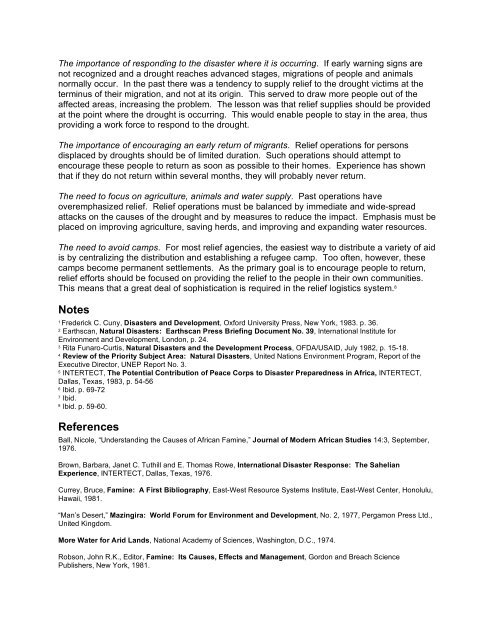Natural Hazards: Causes and Effects - Disaster Management Center ...
Natural Hazards: Causes and Effects - Disaster Management Center ...
Natural Hazards: Causes and Effects - Disaster Management Center ...
Create successful ePaper yourself
Turn your PDF publications into a flip-book with our unique Google optimized e-Paper software.
The importance of responding to the disaster where it is occurring. If early warning signs are<br />
not recognized <strong>and</strong> a drought reaches advanced stages, migrations of people <strong>and</strong> animals<br />
normally occur. In the past there was a tendency to supply relief to the drought victims at the<br />
terminus of their migration, <strong>and</strong> not at its origin. This served to draw more people out of the<br />
affected areas, increasing the problem. The lesson was that relief supplies should be provided<br />
at the point where the drought is occurring. This would enable people to stay in the area, thus<br />
providing a work force to respond to the drought.<br />
The importance of encouraging an early return of migrants. Relief operations for persons<br />
displaced by droughts should be of limited duration. Such operations should attempt to<br />
encourage these people to return as soon as possible to their homes. Experience has shown<br />
that if they do not return within several months, they will probably never return.<br />
The need to focus on agriculture, animals <strong>and</strong> water supply. Past operations have<br />
overemphasized relief. Relief operations must be balanced by immediate <strong>and</strong> wide-spread<br />
attacks on the causes of the drought <strong>and</strong> by measures to reduce the impact. Emphasis must be<br />
placed on improving agriculture, saving herds, <strong>and</strong> improving <strong>and</strong> exp<strong>and</strong>ing water resources.<br />
The need to avoid camps. For most relief agencies, the easiest way to distribute a variety of aid<br />
is by centralizing the distribution <strong>and</strong> establishing a refugee camp. Too often, however, these<br />
camps become permanent settlements. As the primary goal is to encourage people to return,<br />
relief efforts should be focused on providing the relief to the people in their own communities.<br />
This means that a great deal of sophistication is required in the relief logistics system. 8<br />
Notes<br />
1 Frederick C. Cuny, <strong>Disaster</strong>s <strong>and</strong> Development, Oxford University Press, New York, 1983. p. 36.<br />
2 Earthscan, <strong>Natural</strong> <strong>Disaster</strong>s: Earthscan Press Briefing Document No. 39, International Institute for<br />
Environment <strong>and</strong> Development, London, p. 24.<br />
3 Rita Funaro-Curtis, <strong>Natural</strong> <strong>Disaster</strong>s <strong>and</strong> the Development Process, OFDA/USAID, July 1982, p. 15-18.<br />
4 Review of the Priority Subject Area: <strong>Natural</strong> <strong>Disaster</strong>s, United Nations Environment Program, Report of the<br />
Executive Director, UNEP Report No. 3.<br />
5 INTERTECT, The Potential Contribution of Peace Corps to <strong>Disaster</strong> Preparedness in Africa, INTERTECT,<br />
Dallas, Texas, 1983, p. 54-56<br />
6 Ibid. p. 69-72<br />
7 Ibid.<br />
8 Ibid. p. 59-60.<br />
References<br />
Ball, Nicole, “Underst<strong>and</strong>ing the <strong>Causes</strong> of African Famine,” Journal of Modern African Studies 14:3, September,<br />
1976.<br />
Brown, Barbara, Janet C. Tuthill <strong>and</strong> E. Thomas Rowe, International <strong>Disaster</strong> Response: The Sahelian<br />
Experience, INTERTECT, Dallas, Texas, 1976.<br />
Currey, Bruce, Famine: A First Bibliography, East-West Resource Systems Institute, East-West <strong>Center</strong>, Honolulu,<br />
Hawaii, 1981.<br />
“Man’s Desert,” Mazingira: World Forum for Environment <strong>and</strong> Development, No. 2, 1977, Pergamon Press Ltd.,<br />
United Kingdom.<br />
More Water for Arid L<strong>and</strong>s, National Academy of Sciences, Washington, D.C., 1974.<br />
Robson, John R.K., Editor, Famine: Its <strong>Causes</strong>, <strong>Effects</strong> <strong>and</strong> <strong>Management</strong>, Gordon <strong>and</strong> Breach Science<br />
Publishers, New York, 1981.








